Teotihuacan: What to See, How to Get There, Tickets & Tips
Teotihuacan is one of Mexico’s most awe-inspiring archaeological treasures—a must-see destination just an hour from Mexico City.
Steeped in history and mystery, this legendary site captivates both archaeology enthusiasts and curious travelers in search of a truly unique experience.
I must admit, it wasn’t until my third visit to Mexico City that I finally explored Teotihuacan!
Why the wait? I was worried it might disappoint—much like Chichen Itza or Tulum sometimes do when overwhelmed by tourists. Despite their beauty, these sites can lose some of their magic amid large crowds.
Having already visited some quieter, lesser-known ruins like Uxmal, Calakmul, and Edzná, the thought of battling crowds wasn’t appealing.
But I’m so glad I gave it a chance!
Teotihuacan left a lasting impression with its monumental scale, vibrant energy, and deep symbolic meaning. Even if you’ve visited other ruins in Mexico, this site stands out and is absolutely worth your time.
In this complete guide to Teotihuacan, I share everything you need to plan your visit—from what to see and how to get there (on your own or with a guided tour), to where to buy tickets and my top tips for maximizing your experience.
You’ll also find my recommended restaurants and accommodation options for every budget near Teotihuacan.
Ready to plan your visit to Teotihuacan? Let’s dive in!
Sommaire
- Teotihuacan: What to See, How to Get There, Tickets & Tips
- 1. Visit Teotihuacan: book your tickets
- 2. What is Teotihuacan?
- 3. What to See in Teotihuacan
- 4. Hot-air ballooning over Teotihuacan
- 5. The Teotihuacan room at the Museum of Anthropology (Mexico City)
- 6. How long does it take to visit Teotihuacan?
- 7. What’s the best way to visit Teotihuacan?
- 8. How do I get to Teotihuacan from Mexico City?
- 9. Where do I begin my visit to Teotihuacan? Recommended entry points and itineraries
- 10. Teotihuacan tourist map
- 11. Prices, tickets and services at Teotihuacan
- 12. Where to stay when visiting Teotihuacan (Mexico City)
- 13. Frequently asked questions about visiting Teotihuacan
- 13.1 Is it possible to climb the Teotihuacan pyramids?
- 13.2 Do I have to buy my ticket in advance?
- 13.3 Can I take a hot-air balloon ride in Teotihuacan?
- 13.4 What’s the difference between Teotihuacan and Chichen Itza?
- 13.5 Where to eat in Teotihuacan?
- 13.6 Is Teotihuacan accessible to people with reduced mobility?
- 13.7 Can Teotihuacan be visited with children?
- 13.8 What are the site’s opening times?
- 13.9 Are there toilets on site?
- 13.10 When is the best time to visit Teotihuacan?
- 13.11 Are there days when admission is free?
- 13.12 Is Teotihuacan dangerous?
- 13.14 Can I fly a drone in Teotihuacan?
- 13.15 What is the link between Teotihuacan and the Aztecs?
- 13.16 Is it possible to do the tour in half a day from Mexico City?
- 14. What do I need to bring to visit Teotihuacan?
- Renting a Car to Visit Teotihuacan from Mexico City
- How to find the best price for your flight ticket
- You’re traveling in Mexico? These articles will help you!
1. Visit Teotihuacan: book your tickets
If you’d prefer to book your tickets for Teotihuacan without reading the article (although I do recommend it if you’d like to find out all the details about the archaeological site, including practical information!
You can simply click on the name of the ticket you’re interested in to book:
- Early access to Teotihuacan: Morning guided tour with hotel pick-up, visit to an obsidian workshop, tequila tasting and buffet lunch.
- Hot-air balloon flight to Teotihuacan: Hot-air balloon flight over the site and valley of Teotihuacan, with pick-up at your hotel (optional), buffet breakfast, toast and flight certificate. Entrance to Teotihuacan not included.
2. What is Teotihuacan?
Located 25 miles from Mexico City, Teotihuacan was one of the largest cities in Mesoamerica!
With a name meaning Place where men became gods or City of the Gods in Nahuatl, it’s easy to imagine the importance of this city.
It is estimated that the ancient city was founded and occupied by a first group between the 1st and 7th centuries. It reached its apogee in the 5th, when it covered an area of 5,190 acres and was home to 150,000 inhabitants (and perhaps as many as 250,000!) from various regions of Mesoamerica.
The archaeological zone of Teotihuacan has been declared a Unesco World Heritage Site because of its undeniable importance, but many mysteries surround the city:
- Firstly, we still don’t know who was responsible for its construction. And to complicate matters, Teotihuacan is thought to have been a multi-ethnic city! Indeed, excavations have shown the presence of different groups, concentrated in different neighborhoods.
- Nor do we know why it collapsed. Drought, socio-political tensions – the hypotheses are numerous.
- The same deities were worshipped as elsewhere in Mesoamerica (such as the famous feathered serpent Quetzalcóatl and Tlaloc, the god of rain), but their hierarchy is still unknown. We don’t even know to whom the sun and moon pyramids were dedicated!
The Aztecs arrived when the site was abandoned. They built the new city of Teotihuacan and settled there from the 13th to the 16th century, until the Spanish soldiers invaded.
You can also book a hot-air balloon flight over Teotihuacan, one of the most beautiful experiences in Mexico!
3. What to See in Teotihuacan
The Teotihuacan archaeological site spans over 6,180 acres, yet only about 2% has been excavated so far! Still, there’s plenty to explore.
Here’s a list of the must-see highlights of Teotihuacan that you shouldn’t miss during your visit:
3.1 The Pyramid of the Sun or Tonatiuh
At 215 feet, this is the site’s tallest pyramid and Teotihuacan’s main attraction. It is very imposing, and with good reason: its volume reaches over 1 million cubic meters!
A temple once stood atop the pyramid, but has now completely disappeared.
It is considered to be the 2nd largest pyramid in the New World.
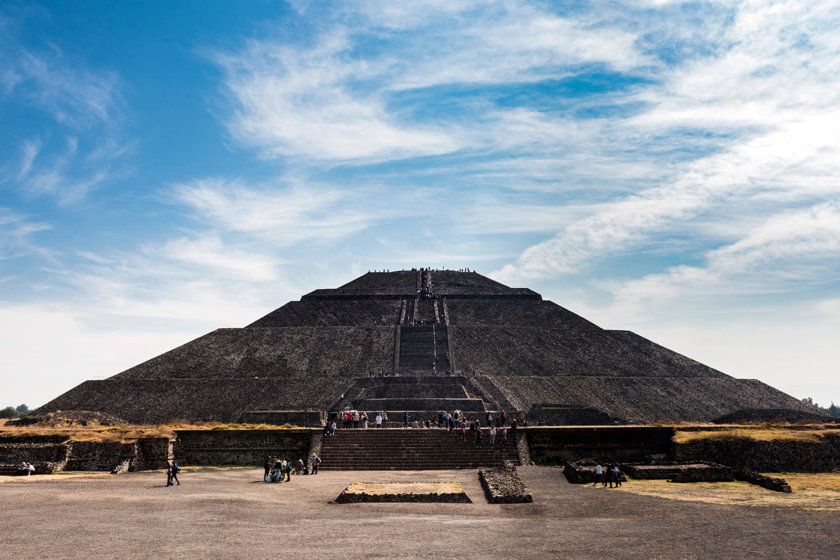
3.2 The Causeway of the Dead
The Calzada de los Muertos is Teotihuacan’s main avenue, linking the Pyramid of the Moon and the ancient city on a north-south axis. So you’re sure to find yourself walking from one structure to the next.
On this grand avenue, don’t miss the lovely Puma Mural, depicting a large feline in profile with its mouth open and its paws with large, protruding claws.
The Aztecs later named it Miccaotli, or the Alley of the Dead, mistakenly believing these structures were tombs. In reality, we now know they were ceremonial temples dedicated to lesser gods.
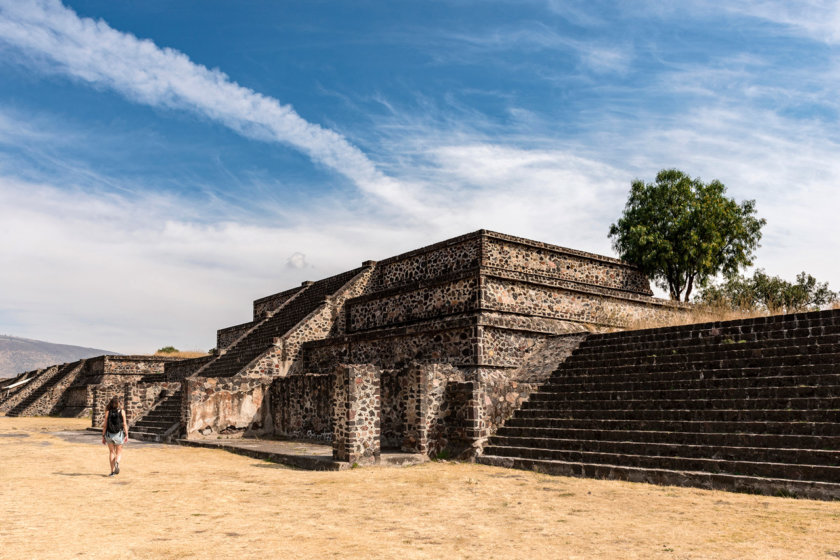
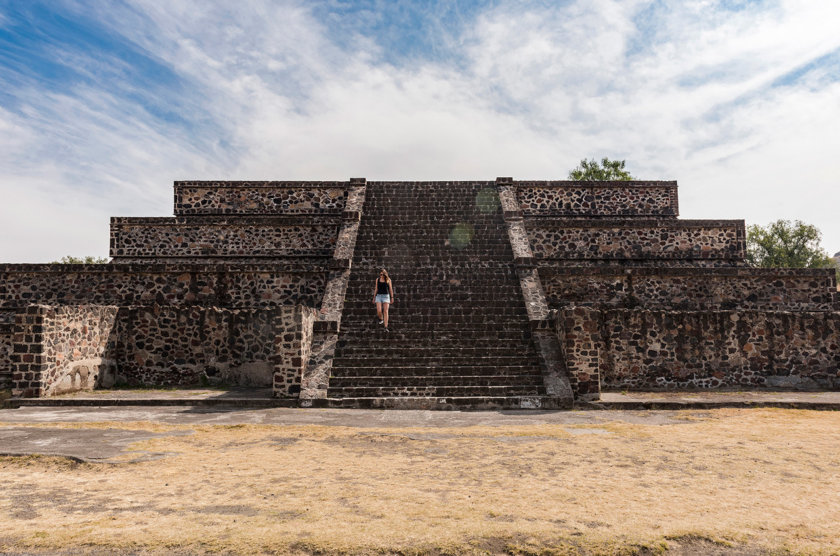
3.3 The Pyramid of the Moon or Meztl Itzaquatl
At the end of the Calzada de los Muertos lies the Pyramid of the Moon.
Unlike the Pyramid of the Sun, which was built in a single phase, this one was built in at least 7 stages between the years 100 and 650, reaching a height of 138 feet.
It stands at the center of the Calzada de los Muertos, and it’s easy to imagine a grand ceremony in this grandiose (and intimidating) setting. Recent excavations inside the Moon Pyramid have uncovered human sacrifices and jade offerings.
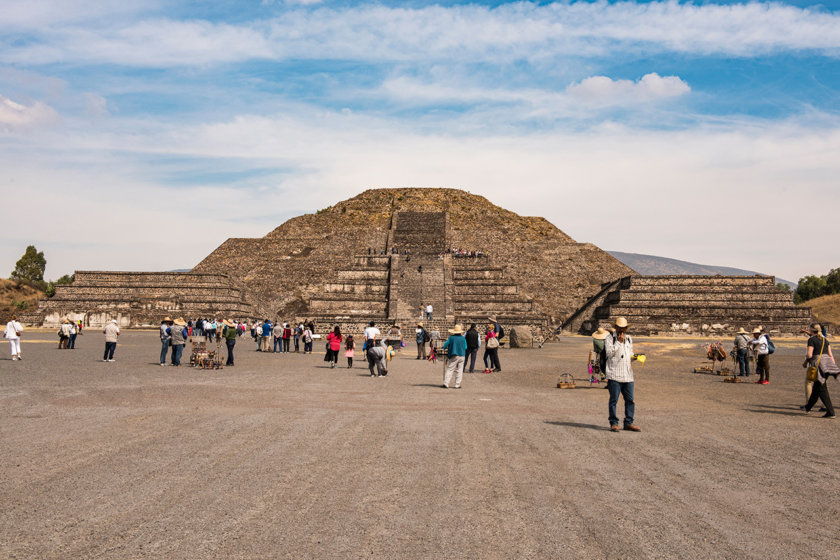
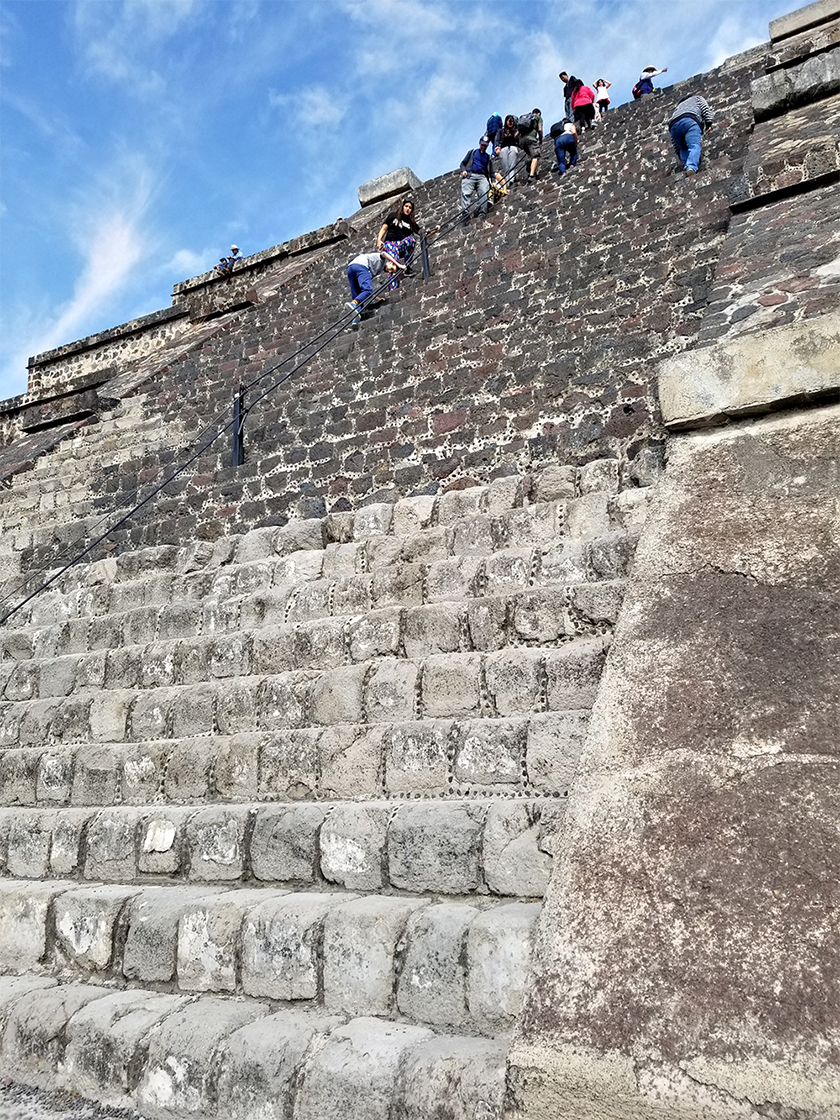
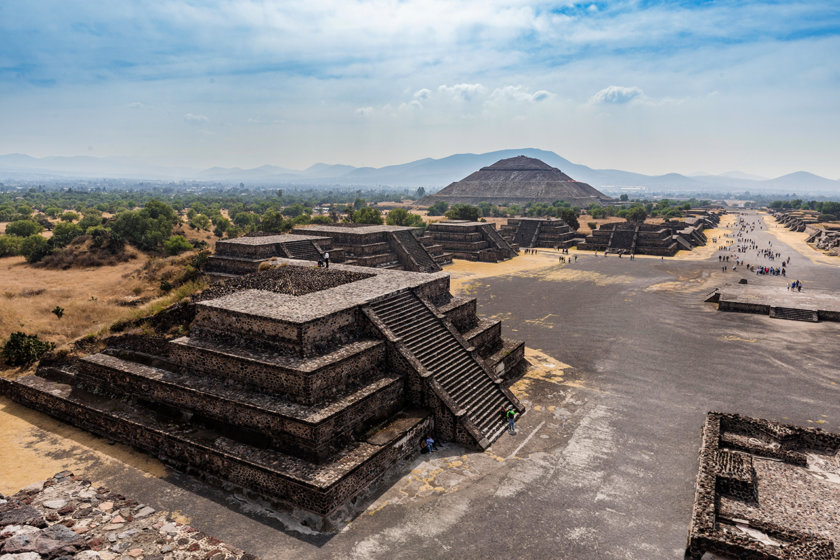
3.4 The Palace of Quetzalpapalotl
This palace, located opposite the Causeway of the Dead, is believed to have been the residence of Teotihuacan’s elite. It comprises three structures that were rebuilt in the 1960s:
- Caracoles emplumados: this is hidden away at the bottom of the Palace and features murals of birds and various symbols, as well as a temple whose door features stone reliefs of snails with feathers (hence its name “feathered snails”)
- Patio de los Pilares: the heart of the complex. It features several representations of birds, including quetzals.
- Patio de los Jaguares
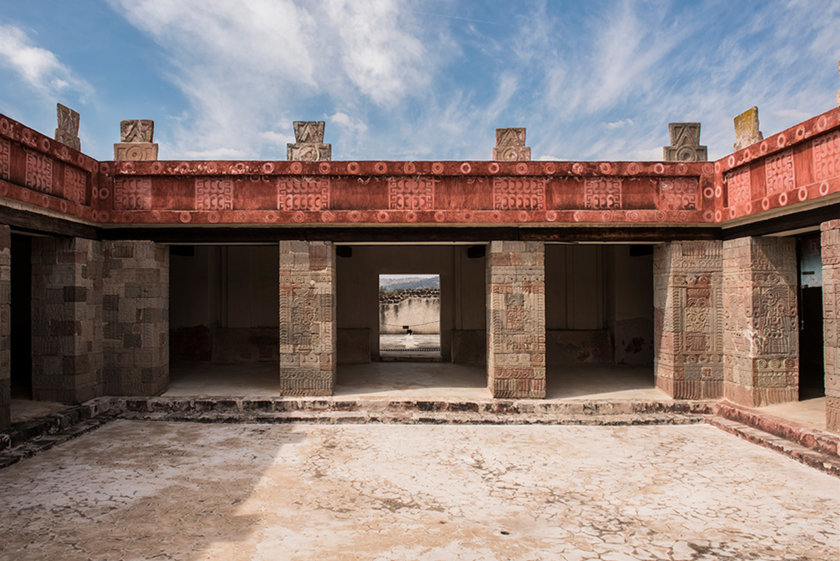
3.5 The citadel
South of the Avenue of the Dead lies the Citadel, named by the Spanish soldiers who believed (wrongly) that it was a military structure.
It is a large archaeological complex housing the Temple of the Feathered Serpent or Temple of Quetzalcoatl, a large public square with an altar at its center and a temple called Edificio Sur.
The facades of the Temple of Quetzalcoatl are magnificent, adorned with over 300 sculptures of feathered serpents, geometric shapes and marine elements.
3.6 Teotihuacan museums
There are two museums on the Teotihuacan site.
Museo de la Cultura teotihuacana (Museum of Teotihuacan Culture): practically glued to the Pyramid of the Sun. Here you’ll find some 600 artifacts and objects of all kinds, religious, artistic and everyday, in a variety of materials (obsidian, ceramics, shell, bone, wood, etc.). It’s an opportunity to learn more about the economic, social, political, technological and religious life of Teotihuacan.
Museo de Murales teotihuacanos (Beatriz de la Fuente) – Museum of Murals: located behind the Pyramid of the Moon, just outside the site. It presents Teotihuacan art (architecture, sculpture, painting) in 9 thematic rooms. You’ll discover the techniques (and evolution) of Teotihuacan murals.
4. Hot-air ballooning over Teotihuacan
A hot-air balloon flight over Teotihuacan is one of the most memorable moments of your trip to Mexico.
The flight lasts about 1 hour, just as the sun rises. The balloon ascends to 2,625 feet, offering an incredible view of the entire site: the pyramids, the Causeway of the Dead and the entire surrounding valley.
It’s the perfect complement to the visit on the ground to understand the scale of Teotihuacan in its day!
I recommend this tour with transfer from Mexico City, it’s much simpler than getting to the take-off point by yourself at 5.30 a.m. (expensive by cab or Uber).
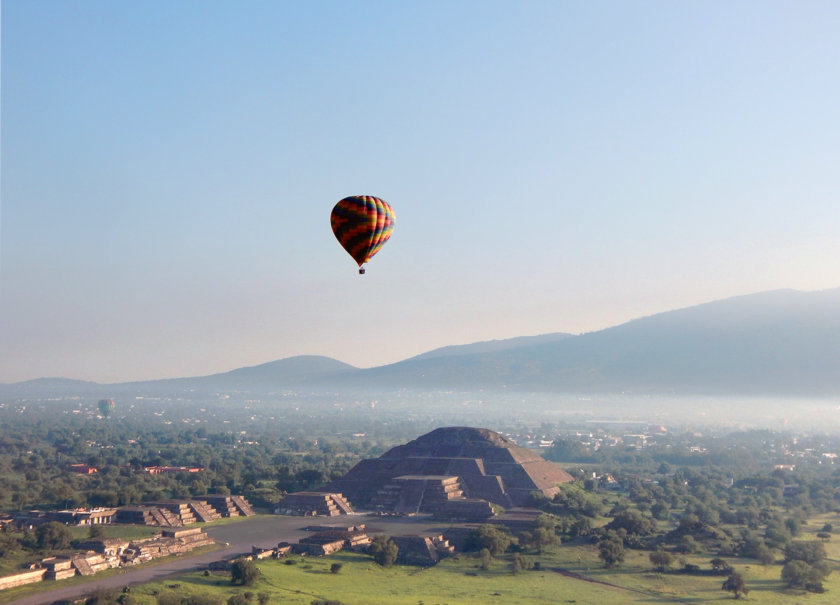
5. The Teotihuacan room at the Museum of Anthropology (Mexico City)
It’s not on the Teotihuacan archaeological site, but if you’re ever in Mexico City, I highly recommend a visit to the National Museum of Anthropology – especially the Teotihuacan room, which is my favorite part of the museum!
There are original pieces, temple reconstructions and one of the most impressive artifacts: the 16-ton monolith of Chalchiuhtlicue, goddess of water.
It’s the perfect place to learn more about the Teotihuacan civilization, before or after visiting the site.
You can also book your special ticket for the museum or the guided tour of the Museum of Anthropology.

6. How long does it take to visit Teotihuacan?
Option 1: Half-day
Teotihuacan is about 1h15 from Mexico City (by car or guided tour).
The site opens at 8am, so you can get there very early. If you’re well organized, or if you choose a morning tour with transport included, you can be among the first to enter and enjoy the site without the crowds or the heat.
If you stay on site for around 3 hours, you’ll have plenty of time to explore the main pyramids and monuments. This leaves you the rest of the day to explore other parts of Mexico City or visit a museum.
Option 2: Full day
If you take a guided tour from Mexico City, plan for a full day of around 8 hours.
In addition to a visit to Teotihuacan, these tours usually include a stop at a local obsidian workshop with a tequila or mezcal tasting, as well as free time for lunch at a local restaurant.
Option 3: With hot-air balloon
The hot-air balloon flight takes place very early in the morning, between around 5 and 9 a.m., depending on weather conditions. Typical schedule: meeting at 5am, take-off around 7am, landing at 8am, followed by a toast.
This is a great activity to combine with a visit to the archaeological site, because after the flight you’re already there. You can then go straight on to discover Teotihuacan on foot, maybe adding an extra 2 to 3 hours to the trip.
7. What’s the best way to visit Teotihuacan?
That depends on the individual traveller!
I visited Teotihuacan once on my own, then several times with an organized tour (when friends or family came to visit). And honestly, both options have their advantages.
Teotihuacan is about 1h to 1h30 from Mexico City, depending on traffic, and as there isn’t much shade on the site, the visit can be quite tiring. So I really appreciated not having to worry about transportation or getting back, especially at the end of the day.
The only downside to some of the tours, in my opinion, is the stop at a craft store. It’s not really my thing, as I never buy souvenirs. But I have to admit that the obsidian explanations and demonstrations are often interesting and well done.
If you prefer to go by yourself (by car or by public transport), I strongly recommend that you take the services of an on-site guide. Otherwise, you run the risk of seeing the site only as a beautiful backdrop for photos, without really understanding its historical and cultural significance.
A good guide will completely transform your visit to Teotihuacan!
8. How do I get to Teotihuacan from Mexico City?
Teotihuacan is about 25 miles northeast of Mexico City, a drive of between 1h and 1h30 depending on traffic. There are three main options for getting there: by car, with an organized tour or by public transport.
8.1 By car
If you’ve rented a car, this is a very practical option. The route is simple: take the Mexico-Pachuca highway (Autopista 85D), then the toll road to San Juan Teotihuacan.
GPS works perfectly on this route – I recommend downloading the Waze application, which is even better than Google Maps.
The toll is around 83 pesos per trip. You can check the updated rates on the official Traza tu Ruta website.
8.2 On a guided tour
In my opinion, this is the most convenient and comfortable way to visit Teotihuacan, especially if you don’t want to deal with travel arrangements or schedules.
Plus, a guide helps you better understand this fascinating archaeological site!
I recommend this morning excursion, which includes round-trip transportation from Mexico City, a guided tour of the site, and a tasting of tequila, mezcal and pulque in an obsidian workshop.
8.3 By public transport
This is an economical option, but less comfortable. It can be tiring, and the transport isn’t the most pleasant.
Here’s what to do if you choose this option:
- Take metro line 5 (yellow) to Autobuses del Norte station.
- At the bus station, go to gate 8 and board one of the “Autobuses Teotihuacan“.
The journey takes about 1 hour, and the ticket costs 55 pesos each way (cash only), with departures every 10 to 15 minutes.
9. Where do I begin my visit to Teotihuacan? Recommended entry points and itineraries
If you’re visiting Teotihuacan on your own, it’s important to choose the right gateway and itinerary to get the most out of the site.
9.1 The gates of Teotihuacan
The site has 5 main access gates, each with its own particularities:
- Gate 1: located at the beginning of the Avenue of the Dead, this is the busiest, but also the most logical for visiting the monuments in a coherent order. This is the one I recommend if you want a well-structured visit.
- Gate 2: directly opposite the Pyramid of the Sun. It’s spectacular on arrival, but less practical because you have to retrace your steps.
- Gate 3: closest to the Pyramid of the Moon and the Museum of Mural Paintings. A good choice for those who want to see these elements first.
- Gate 4: behind the Pyramid of the Sun, provides more direct access to this area, but not ideal for a first visit.
- Gate 5: also at the rear of the pyramid, on the other side of Gate 4. This is the closest access to the Museum of Teotihuacan Culture.
9.1 Routes to Teotihuacan
INAH (National Institute of Anthropology and History) offers two itineraries to suit your interests:
Monuments Route (approx. 2h): starting at Gate 1 and ending at Gate 3. It allows you to visit the major emblematic sites: Ciudadela, Temple of Quetzalcoatl, Pyramid of the Sun, Causeway of the Dead, Pyramid of the Moon.
Murals Route (approx. 1h45): starts at Gate 3 and ends at Gate 4. It focuses on themural art of Teotihuacan: the Mural Museum, the Palace of Quetzalpapalotl, the Temple of the Jaguars, the Mural of the Puma, and above all the Tepantitla complex, home to the famous Tlalocan fresco.
You can also visit the Tetitla and Atetelco residential complexes, located outside the main archaeological zone. You’ll discover rooms, patios and streets of the city, with several well-preserved murals. Follow the path between gates 1 and 2: a sign indicates the direction.
10. Teotihuacan tourist map
Here’s a tourist map of Teotihuacan to help you plan your visit.
It includes the main pyramids, the museums, the various entrance gates, as well as the two itineraries suggested by INAH (Monuments Route and Murals Route). Feel free to open it before your visit to familiarize yourself with the area.
I strongly recommend keeping it open on your phone during your visit, or downloading it in advance for offline use. The site is vast and there’s not always a signal, so it’s best to be prepared so you don’t miss a thing!
11. Prices, tickets and services at Teotihuacan
Teotihuacan entrance fee: 100 pesos per person (2025 rate).
Parking: 60 pesos per car, to be expected if you come with a rental car.
Guided tour: if you wish to take the tour with a guide, prices vary according to duration (between 1h and 3h) and language chosen. Allow between 850 and 1,500 pesos for the whole group. Rates are per group, not per person, so if you have the opportunity to join other travelers, you can share the cost.
12. Where to stay when visiting Teotihuacan (Mexico City)
The best way to visit Teotihuacan is to spend the night in Mexico City and take a day trip.
Here’s my selection of the best hotels in Mexico City, according to your budget:
- Hostel Mundo Joven Catedral (historic center): one of the best hostels in Mexico City. Friendly staff, simple but clean dormitories and rooms. A particular highlight is the rooftop terrace with bar, offering a great atmosphere and an exceptional view of the cathedral and the Zocalo. From just 16 in a dorm and 35$ usd in a private room!
- Hotel Villa Condesa (Condesa): if you’re looking for a romantic hotel in Mexico City, here’s an oasis of peace in the heart of the La Condesa district. It’s an elegant house with small green terraces and tastefully decorated sitting areas. The rooms are spacious and modern, the service particularly attentive and the breakfast very good. From 173$ USD per night
- Hotel Casa Goliana (Roma Norte): top-of-the-range hotel with the best value for money in its category, located in an early 20th-century house typical of the La Roma district. Rooftop terrace, comfortable rooms, very attentive staff and good breakfast. From 210 USD per night
- Four Seasons Hotel Mexico City (Juarez): this 5* hotel is one of the best in Mexico City, ideal for a business trip or a romantic getaway. Located on Paseo de la Reforma between Colonia Juarez and Roma Norte. Large indoor garden, gym, pool, spa, restaurant and bar. From 690 USD per night!
13. Frequently asked questions about visiting Teotihuacan
13.1 Is it possible to climb the Teotihuacan pyramids?
Since 2020, access to the pyramids has been restricted for conservation reasons. The Pyramid of the Sun is still closed, and can only be admired from below – it’s quite impressive!
Good news: access to the Pyramid of the Moon has just been reopened, but only up to the first landing.
13.2 Do I have to buy my ticket in advance?
It’s perfectly possible to buy your ticket directly on site if you want to go there on your own. But beware: many groups arrive at the same time, and there may be a wait.
The easiest way is to book an organized tour in advance. You’ll have transportation included, a professional guide (often an archaeologist), and you’ll avoid long queues.
13.3 Can I take a hot-air balloon ride in Teotihuacan?
Yes, it’s one of the most spectacular things to do in Teotihuacan! Flights take place very early in the morning. Allow around 3 hours, including preparation, the flight and a toast after landing.
You can then begin your tour of the archaeological site at your leisure.
Book your hot-air balloon flight here:
13.4 What’s the difference between Teotihuacan and Chichen Itza?
Both sites are UNESCO World Heritage Sites, but they belong to different cultures, different periods, and have very distinct architectural styles.
Teotihuacan is located some 25 miles northeast of Mexico City. It was founded around the 1st century AD, long before the arrival of the Mexicas (Aztecs), who didn’t appear in the region until the 14th century. We still don’t know which civilization built it, which makes it one of Mexico’s most mysterious archaeological sites.
It stands out for its immense avenues, the Pyramid of the Sun, the Pyramid of the Moon, and its advanced urban planning.
Chichen Itza, on the other hand, is located on the Yucatán peninsula. Founded around the 6th century by the Itzaes, it was an important center of Mayan civilization until the 13th century.
It is famous for its Kukulcán pyramid, ball game and sacred cenotes.
13.5 Where to eat in Teotihuacan?
There are plenty of restaurants around Teotihuacan, but be warned: many of them are mere tourist traps. Here are my personal recommendations if you’re looking for a good place to eat after your visit:
Techinanco: a small, unpretentious local restaurant where abuelitas cook good, traditional Mexican dishes. The atmosphere is simple, the prices are reasonable, and it’s delicious. It’s just a 5-minute walk from Gate 3 (behind the Pyramid of the Moon).
Gran Teocalli: a good option if you’re visiting Teotihuacan with the family. The place is spacious, decorated with murals and traditional objects. It offers a varied buffet, practical for children, as well as a music and dance show. Website
La Gruta: Teotihuacan’s most famous restaurant, located in a real cave. The setting is impressive and worth the detour for the experience. On the other hand, the food is expensive and not always up to scratch. My advice: have a cocktail or juice, share an appetizer (guacamole!) and enjoy the place. Website
La Caverna: a smaller, more intimate alternative to La Gruta. The service is attentive, the prices more affordable, and the atmosphere pleasant. My margarita was excellent! Facebook page
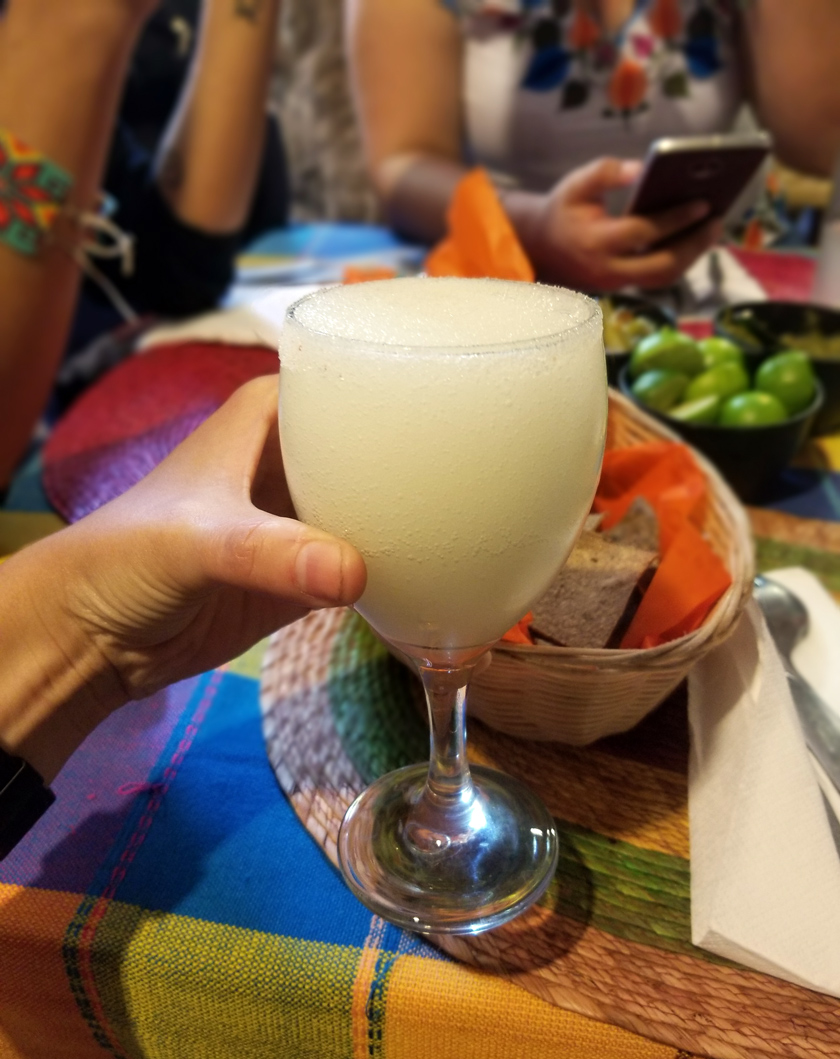
13.6 Is Teotihuacan accessible to people with reduced mobility?
Yes, Teotihuacan is partially accessible to people with reduced mobility, including wheelchair users, but certain conditions must be taken into account.
Gate 5 is the only entrance with accessible parking. It is located behind the Pyramid of the Sun, close to the Teotihuacan Museum and adapted toilets.
Gate 2 is another possible option. It’s well located, but beware: the parking lot is unmarked, on a dirt surface, so you’ll have to improvise an accessible spot.
Once inside, you enter the Avenida de los Muertos (Road of the Dead), which crosses the site. It’s a wide and relatively flat avenue, allowing you to approach the main structures such as the Pyramid of the Moon and other ruins.
However, the surface of the avenue is irregular, made up of earth, gravel and old cobblestones. Gravel predominates, which can be tiring to navigate in a manual wheelchair.
If you’re hesitating between a manual and a motorized wheelchair, choose the motorized one for greater comfort and safety.
That said, even with a manual one, the tour is still feasible and well worth the detour.
13.7 Can Teotihuacan be visited with children?
Yes, visiting Teotihuacan with children is entirely possible, and can even be quite an adventure for them. They generally love running around the site and exploring the ruins.
However, you’ll need to prepare them well: cap or hat, sun cream and water, as there’s very little shade and the visit can be tiring, especially in full sun.
For a pleasant break, consider family-friendly restaurants such as Gran Teocalli, with its buffet and live entertainment.
13.8 What are the site’s opening times?
The Teotihuacan archaeological site is open daily from 8am to 5pm, all year round.
Entrance is permitted until 3pm at the latest. It is strongly recommended to arrive early in the morning, especially on weekends, during vacations or in high season (November-April), to avoid crowds and take advantage of the cooler temperatures.
13.9 Are there toilets on site?
Yes, there are toilets at Teotihuacan, located mainly at the entrance to the site, near gates 1, 2, 3 and 5.
It’s advisable to go there when you arrive, as there are no toilets in the central area of the site, around the pyramids. Some gates also have accessible bathrooms, as is the case at Gate 5.
13.10 When is the best time to visit Teotihuacan?
The best time to visit Teotihuacan is from November to April, during the dry season. The skies are generally clear, the weather is fine and not so hot.
The summer months(June to September) correspond to the rainy season: showers often fall at the end of the day, but this is not a rule, so it’s best to visit in the morning.
Whatever the season, remember to protect yourself from the sun: there’s very little shade on site, and temperatures can quickly rise during the day.
13.11 Are there days when admission is free?
Yes, entry to Teotihuacan is free on Sundays for Mexican citizens and permanent residents of Mexico.
This is a great opportunity for locals, but it also means that the site is often much busier on this day.
If you’re looking for peace and quiet and want to avoid the crowds, it’s best to choose another day of the week for your visit.
13.12 Is Teotihuacan dangerous?
No, Teotihuacan is a very touristy and safe archaeological site.
There is a police presence in and around the site, and visitors come in large numbers every day.
Of course, it’s important to use common sense, especially when taking public transport, or in the areas around the site, keeping an eye on your personal belongings.
13.14 Can I fly a drone in Teotihuacan?
No, drones are prohibited at Teotihuacan without official authorization issued by the INAH (National Institute of Anthropology and History).
Checks are carried out at the entrance to the site, and there are heavy fines for violations.
13.15 What is the link between Teotihuacan and the Aztecs?
The Aztecs (or Mexicas) didn’t build Teotihuacan. When they arrived in the region, the city had already been abandoned for centuries.
Fascinated by its grandeur, they considered it a sacred site and named it Teotihuacan, meaning “the place where the gods were born”.
Even today, it’s not known for sure who founded the city, but it was already flourishing more than 1,000 years before the arrival of the Aztecs.
13.16 Is it possible to do the tour in half a day from Mexico City?
Yes, if you leave early in the morning and visit on your own or with an express tour.
Teotihuacan is about 1 hour’s drive from Mexico City, so the round trip can be done in half a day.
However, most organized tours include other stops such as an obsidian workshop, a meal or a pulque or mezcal tasting. In this case, you’ll need to allow for a full day of approximately 8 hours.
14. What do I need to bring to visit Teotihuacan?
Before setting off for Teotihuacan, it’s best to be well prepared, as the site is vast, with little shade, and the experience can quickly become tiring if you’re not well equipped.
Comfortable footwear: you don’t need trekking boots, but sneakers or sports shoes are essential. You’ll be doing a lot of walking, often on uneven surfaces, and climbing many steps, especially if you’re exploring the pyramids.
Water: indispensable, especially in hot weather. It is possible to buy some locally, but prices are higher and options limited.
Sun protection: there’s very little shade on site. So bring a cap or hat, sunscreen and sunglasses.
Appropriate clothing: opt for light, breathable clothing, but also pack a light knit or jacket. Mornings are often cool, especially if you leave early from Mexico City.
Raincoat or poncho: in the rainy season (June to September-early October), it can rain at any time, although showers generally occur in the afternoon.
Cash: it’s always a good idea to carry Mexican pesos. Some vendors, parking lots and services do not accept credit cards.
Renting a Car to Visit Teotihuacan from Mexico City
If you’re planning to visit Teotihuacan from Mexico City, renting a car is one of the best options—especially if you want flexibility and the chance to explore other nearby destinations at your own pace.
While a car isn’t necessary to get around Mexico City itself, having your own vehicle is a big advantage for day trips like Teotihuacan, and even more so if you’re continuing your journey through central Mexico.
Personally, I always use Booking.com Cars for a few key reasons:
- Easy price comparison: you can instantly check rates from all major agencies and find the best deal.
- Free cancellation on most bookings: perfect if your plans change.
- Better insurance at a lower cost: Booking.com offers full coverage that’s often cheaper than what rental companies provide directly.
Click the green button below to find the best rental car deals for your Teotihuacan trip:
How to find the best price for your flight ticket
Mexico City Airport officially named Benito-Juárez International Airport receives a lot of national and international flights. It is the most important airport in Latin America!
To save money on flight tickets, you can use our flight comparator for Mexico, in partnership with Skyscanner: it’s the guarantee to pay the best price for your international and domestic flights!
🚗 Rent a car
🗽 Book entrance tickets and guided visits
🏄 Book your sports activities
🌍 Take a travel insurance
🙎 Book a tour
✈️ Book your flight
You’re traveling in Mexico? These articles will help you!
Discover all my articles about Mexico: All my articles to help you plan your trip to Mexico are listed there.
- Mexico City: The 45 Best things to Discover
- 1 Day in Mexico City – How to spend just 24h in the Mexican capital
- 2 Days in Mexico City – The perfect itinerary for 48h!
- 3 Days in Mexico City – The Best Itinerary + Where to Stay
- 4 Days in Mexico City – Your Four-Day Must-See Guide
- Where to stay in Mexico City? – Best areas and hotels for all budgets!
- Mexico City on a Budget: Guide + All my Best Tips to Save Money
- The Definitive Guide to 40 Best Free Things to Do in Mexico City
- World Cup 2026 Mexico: Guide, Tickets, Stadiums + Tips
- Day of the Dead in Mexico City: All the Best Things to Do and See
- Anthropology Museum (Mexico City): Tickets & Must-Know Tips
- How to Visit Xochimilco (Mexico City): The Ultimate Guide
- Coyoacán (Mexico City): the Best Things to Do in Frida Kahlo’s Neighborhood
- Lucha Libre in Mexico City (Tickets, Venues, Tips & More!)
- 40+ Wifi Cafes in Mexico City that Every Digital Nomad Should Know About
- Muralism in Mexico City: The Essential Guide to the Best Murals
- Itinerary: 8-10 days in Mexico – From Mexico City to Oaxaca
- Itinerary: 10 days in Mexico – Mexico City, Chiapas and Yucatan
- Itinerary: 2 weeks in Mexico – Best itinerary to discover the Yucatan Peninsula and Chiapas!
- Itinerary: 3 weeks in Mexico – Mexico City, Puebla, Oaxaca, Chiapas, Campeche, Yucatán and Riviera Maya
- Itinerary: 1 month in Mexico – My Epic 30-31 Days Itinerary from Mexico City to Cancun
- Road trip in Mexico: The best itineraries for 10, 15, 21 days and a month
- Itinerary: 1 week in Yucatan – The Ultimate 6, 7 or 8 days Itinerary
- Itinerary: 10 days in Yucatan – Best Itinerary for 9, 10 or 11 Days in Yucatan
- Itinerary: 2 weeks in Yucatan – Epic Itinerary + All my Best Tips!
- Itinerary: 3 weeks in Yucatan – Best things to do in 20-21 days
- Itinerary: 1 month in Yucatan – Yucatan Peninsula in 29, 30 or 31 days from Cancun
- Road trip in Yucatan: The best itineraries for 7, 10, 15, 21 days and 1 month
You’re using Pinterest? Here is the picture to pin!
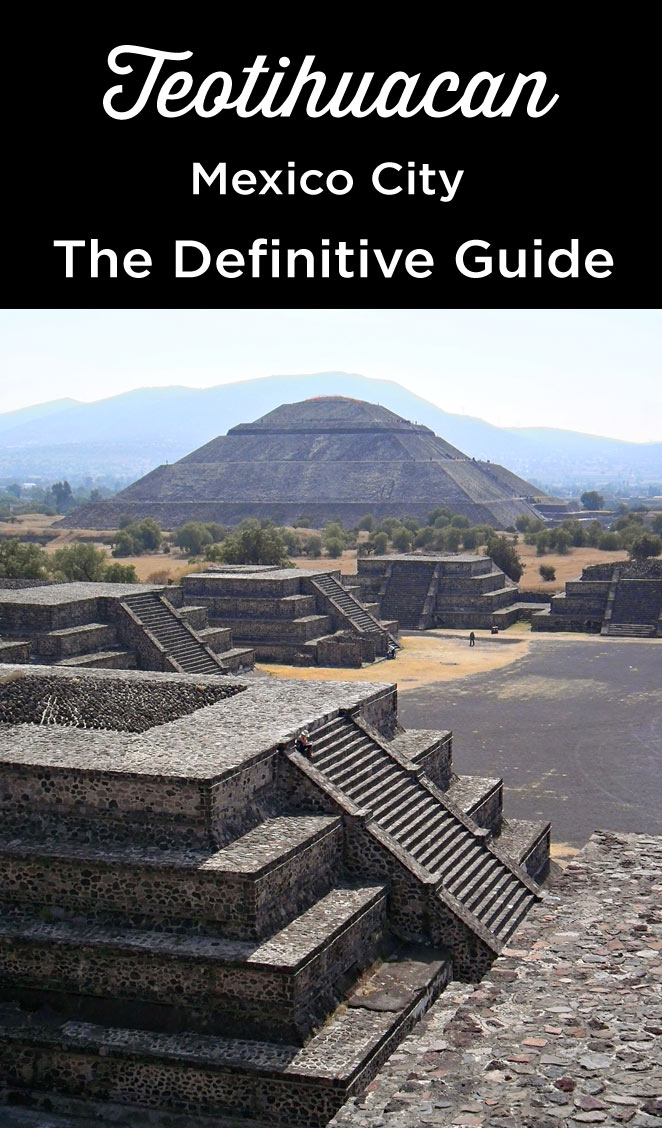





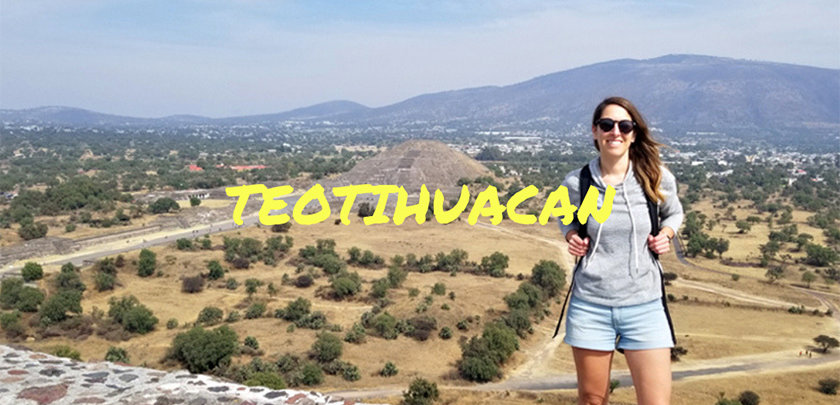



Discussion4 Comments
Hi! I appreciate very much your comprehensive guide (with bits of fun trivia) of Teotihuacan. Very helpful to a solo and DIY traveler like me. Thank you!
I’m very happy to be able to help solo travellers like me! Have a nice trip
Vanessa, thank you for your detailed information about Teotihuacan and its pyramids.
But I will give you some information that you did not know, and it is as follows:
In June 1972, there were no fences or gates around the whole perimeter of the pyramids area, there were
no police, you could come any time, clime both pyramids without any restrictions, and it was FREE !!
The entrance to the Anthropological Museum in Mexico City, was also FREE !!
There was no time restriction for visiting the whole area. Yes, it is hard for you to believe it, but that how
was Mexico in those days. Mexican people and no Mexicans could come freely, without any charge !!
And that is the truth, I had been there and then. You can pass this information to the future visitors,
probably for their big surprise, ha!
Hi Dan!
Thank you so much for sharing this! It’s truly fascinating to imagine Teotihuacan and the National Museum of Anthropology (that I love so much!) completely open and free like that — such a different era.
My parents actually visited Teotihuacan in 1978, and my mom climbed the Pyramid of the Moon wearing high heel… And to make the story even wilder, the tour bus left without them. They suddenly found themselves in the middle of nowhere, with almost no one around… except for one kind Mexican woman who agreed to share a taxi with them. So yes, I can absolutely believe that things were very different back then. Every era has its own charm, doesn’t it?
Thanks again for sharing your experience!